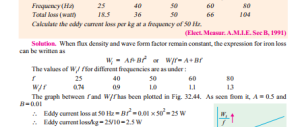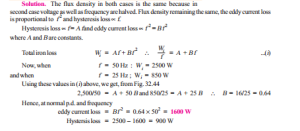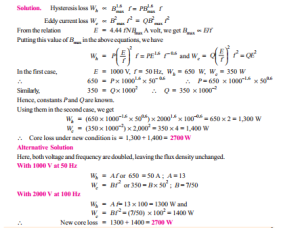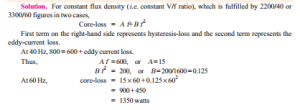Separation of Core Losses
The core loss of a transformer depends upon the frequency and the maximum flux density when the volume and the thickness of the core laminations are given. The core loss is made up of two parts
(i) hysteresis loss W = PB1.6 f as given by Steinmetz’s empirical relation and (ii) eddy current loss f 2 where Q is a constant. The total core-loss is given by
If we carry out two experiments using two different frequencies but the same maximum flux density, we should be able to find the constants P and Q and hence calculate hysteresis and eddy current losses separately.
Example 32.29. In a transformer, the core loss is found to be 52 W at 40 Hz and 90 W at 60 Hz measured at same peak flux density. Compute the hysteresis and eddy current losses at 50 Hz.
(Elect. Machines, Nagpur Univ. 1993)
Solution. Since the flux density is the same in both cases, we can use the relation
Example 32.30. In a power loss test on a 10 kg specimen of sheet steel laminations, the maximum flux density and waveform factor are maintained constant and the following results were obtained:
Example 32.31. In a test for the determination of the losses of a B 440-V, 50-Hz transformer, the total iron losses were found to be 2500 W at normal voltage and frequency. When the applied voltage and A frequency were 220 V and 25 Hz, the iron losses were found to be 850 W. f Calculate the eddy-current loss at normal voltage and frequency.
(Elect. Inst. and Meas. Punjab Univ. 1991)
Example 32.32. When a transformer is connected to a 1000-V, 50-Hz supply the core loss is 1000 W, of which 650 is hysteresis and 350 is eddy current loss. If the applied voltage is raised to 2,000 V and the frequency to 100 Hz, find the new core losses.
Example 32.33. A transformer with normal voltage impressed has a flux density of 1.4 Wb/m2 and a core loss comprising of 1000 W eddy current loss and 3000 W hysteresis loss. What do these losses become under the following conditions ?
(a) increasing the applied voltage by 10% at rated frequency.
(b) reducing the frequency by 10% with normal voltage impressed.
(c) increasing both impressed voltage and frequency by 10 per cent.
(Electrical Machinery-I, Madras Univ. 1985)
Example 32.34. A transformer is connected to 2200 V, 40 Hz supply. The core-loss is 800 watts out of which 600 watts are due to hysteresis and the remaining, eddy current losses. Determine the core-loss if the supply voltage and frequency are 3300 V and 60 Hz respectively.
(Bharathiar Univ. Nov. 1997)







Please i need the drive of Eddy current